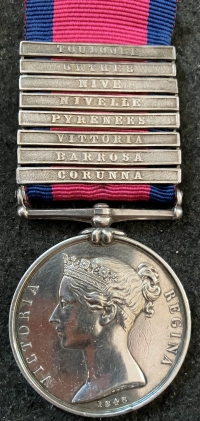

An Outstanding& Very Rare, Officer’s ”Eight Clasp”
Military General Service Medal.
Captain William Henry HARTMAN 28th Foot Regt.
(The North Gloucestershire Regt)
With Superb Early Pedigree from 1903.
[THE MEDAL] 8 Clasps.
-This is the maximum number of clasps to a 28th Foot Officer-
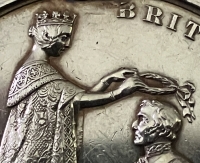 Toulouse, Orthes, Nive, Nivelle,
Pyrenees, Vittoria, Barrosa, Corunna.
Toulouse, Orthes, Nive, Nivelle,
Pyrenees, Vittoria, Barrosa, Corunna.

 W.H. HARTMAN , CAPTn. 28th FOOT.
Medal is officially impressed with the rank shown as CAPTn
after his promotion. (He is shown as a subaltern on the roll).
[WILLIAM HENRY HARTMAN] c, 1791-1876. (85)
[THE OLDEST FIELD OFFICER IN THE BRITISH ARMY. AT THE TIME OF HIS DEATH IN 1876 HE HAD SERVED FOR 73 YEARS]
William Henry Hartman was born on the West Indian Island of St Kitts in 1791 the son of Issac Hartman.
William joined the British Army at the incredibly early age of 12, and was appointed Ensign in the 28th Foot on 9th July 1803.
He became Lieutenant on 28th March 1805, and after his petition of self recommendation, he was indeed promoted to the rank of Captain on 30th October 1812 and Major 22nd July 1830. All his promotional steps to his final rank of Major being solely due to his personal military merit and without any purchase.
He married twice, first to Elizabeth Akers in 1815 at Acton, Middlesex and they had a daughter Rosa born in 1831. His second marriage was in 1842 at St Pancras, London, to Mary Steadman Berkeley. The second marriage being due to the death of his first wife. We have the full details of both marriages with full supporting documentation. William spent many years on half pay and eventually went to live in St Hellier in Jersey, Channel Islands, where he employed a mother and daughter team as housekeepers. He died age 85 after what was an incredible life.
After the Battle of Barrosa in 1812, as a subaltern, and through his two immediate senior officers, William Hartman had petitioned HRH The Duke of York for a promotion to the rank of Captain.
He had, in support of his claim, pointed out his own exemplary service in the action at Barrosa. The promotion was duly granted by the Duke on 30th October 1812 and thus his rank on the medal is correctly shown as Captain.
W.H. HARTMAN , CAPTn. 28th FOOT.
Medal is officially impressed with the rank shown as CAPTn
after his promotion. (He is shown as a subaltern on the roll).
[WILLIAM HENRY HARTMAN] c, 1791-1876. (85)
[THE OLDEST FIELD OFFICER IN THE BRITISH ARMY. AT THE TIME OF HIS DEATH IN 1876 HE HAD SERVED FOR 73 YEARS]
William Henry Hartman was born on the West Indian Island of St Kitts in 1791 the son of Issac Hartman.
William joined the British Army at the incredibly early age of 12, and was appointed Ensign in the 28th Foot on 9th July 1803.
He became Lieutenant on 28th March 1805, and after his petition of self recommendation, he was indeed promoted to the rank of Captain on 30th October 1812 and Major 22nd July 1830. All his promotional steps to his final rank of Major being solely due to his personal military merit and without any purchase.
He married twice, first to Elizabeth Akers in 1815 at Acton, Middlesex and they had a daughter Rosa born in 1831. His second marriage was in 1842 at St Pancras, London, to Mary Steadman Berkeley. The second marriage being due to the death of his first wife. We have the full details of both marriages with full supporting documentation. William spent many years on half pay and eventually went to live in St Hellier in Jersey, Channel Islands, where he employed a mother and daughter team as housekeepers. He died age 85 after what was an incredible life.
After the Battle of Barrosa in 1812, as a subaltern, and through his two immediate senior officers, William Hartman had petitioned HRH The Duke of York for a promotion to the rank of Captain.
He had, in support of his claim, pointed out his own exemplary service in the action at Barrosa. The promotion was duly granted by the Duke on 30th October 1812 and thus his rank on the medal is correctly shown as Captain.
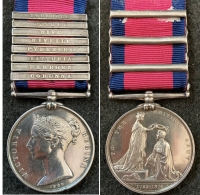 He served in the expedition to Hanover in 1805-06, at the siege of Copenhagen in 1807, and in Portugal and Spain in 1808-09, including the actions relating to the retreat of the Army and battle of Corunna. He also served in the expedition to the Walcheren in 1809, and in the Peninsula and France, including the defence of Tarifa and Cesar Viegas, the battle of Barrosa, actions at Arroyo del Molino and Almarez, Maya Pass, Pyrenees, Nivelle, Nive, Bayonne, Orthes, affair at St Palais and the battle of Toulouse.
After the Battle of Vitoria, Captain Hartman further distinguished himself in the action on the heights of El Ariba, when the outlying picquets of the brigade, which he commanded, were attacked by a strong force of the enemy.
He served in the expedition to Hanover in 1805-06, at the siege of Copenhagen in 1807, and in Portugal and Spain in 1808-09, including the actions relating to the retreat of the Army and battle of Corunna. He also served in the expedition to the Walcheren in 1809, and in the Peninsula and France, including the defence of Tarifa and Cesar Viegas, the battle of Barrosa, actions at Arroyo del Molino and Almarez, Maya Pass, Pyrenees, Nivelle, Nive, Bayonne, Orthes, affair at St Palais and the battle of Toulouse.
After the Battle of Vitoria, Captain Hartman further distinguished himself in the action on the heights of El Ariba, when the outlying picquets of the brigade, which he commanded, were attacked by a strong force of the enemy.
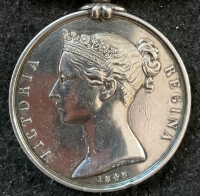
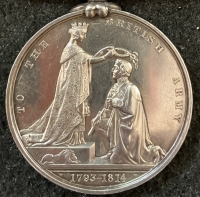 Hartman gallantly defended his post for seven hours, until turned on both flanks, and when obliged to retire, he covered the retreat of some Portuguese, who were hard pressed, for which he received the personal thanks of Sir Rowland Hill (1st Viscount Hill) on his re-joining the brigade.
The Portuguese troops were giving way on being attacked by a superior force of the enemy, when, fortunately for Sir Rowland, Captain Hartman just happened to be close by with two companies of the 28th. Hartman was ordered to their support, with instructions to rally the Portuguese, and then drive the enemy down the hill.
The first instruction was instantly accomplished, and at the point of the bayonet Captain Hartman and his men very soon effected the order to drive the enemy off the hill.
On their return, Colonel James Rooke was sent by Sir Rowland to personally thank Captain Hartman for his speedy and effective response.
Hartman gallantly defended his post for seven hours, until turned on both flanks, and when obliged to retire, he covered the retreat of some Portuguese, who were hard pressed, for which he received the personal thanks of Sir Rowland Hill (1st Viscount Hill) on his re-joining the brigade.
The Portuguese troops were giving way on being attacked by a superior force of the enemy, when, fortunately for Sir Rowland, Captain Hartman just happened to be close by with two companies of the 28th. Hartman was ordered to their support, with instructions to rally the Portuguese, and then drive the enemy down the hill.
The first instruction was instantly accomplished, and at the point of the bayonet Captain Hartman and his men very soon effected the order to drive the enemy off the hill.
On their return, Colonel James Rooke was sent by Sir Rowland to personally thank Captain Hartman for his speedy and effective response.
 Captain William Henry Hartman is seen in the Army List of 1817 on half pay with 28th Foot and having been so since 1814 he clearly did not fight at Waterloo. He is later seen continuing on the half pay list at the rank of Major (unattached).
Captain William Henry Hartman is seen in the Army List of 1817 on half pay with 28th Foot and having been so since 1814 he clearly did not fight at Waterloo. He is later seen continuing on the half pay list at the rank of Major (unattached).
 He was then transferred from the 28th Foot half-pay list to 9th Foot (Royal Norfolk Regt) to be Captain, vice Chaloner Ogle, who exchanged on 6th September 1831. He was again placed on the half-pay list on 16th February 1844.
He was then transferred from the 28th Foot half-pay list to 9th Foot (Royal Norfolk Regt) to be Captain, vice Chaloner Ogle, who exchanged on 6th September 1831. He was again placed on the half-pay list on 16th February 1844.
 Captain Hartman is then again shown on the Army list of 1845.
Captain Hartman is then again shown on the Army list of 1845.
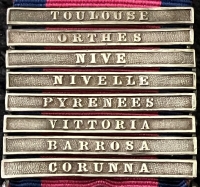 [SUMMARY]
All M.G.S. medals are scarce, with the larger multi-clasp awards being particularly rare & very much sought after. So to locate an eight clasp medal of this description awarded to an officer is an excessively difficult task.
Here we have such a medal which despite being issued 176 years ago in 1848 is also still in exceptional EF+ condition, having obviously been seldom (if ever) worn by the recipient.
[WITH AN INCREDIBLE 121 YEAR PEDIGREE]
1903. Glendinning
1952. Glendinning (ex-Leyland Robinson Collection)
1990. Christie
2002. DNW.(ex-John Seabrook Collection) £2,760 inc’ comm’.
c, 2020. Liverpool Medal Company.
2024. Medals of England.
[SUMMARY]
All M.G.S. medals are scarce, with the larger multi-clasp awards being particularly rare & very much sought after. So to locate an eight clasp medal of this description awarded to an officer is an excessively difficult task.
Here we have such a medal which despite being issued 176 years ago in 1848 is also still in exceptional EF+ condition, having obviously been seldom (if ever) worn by the recipient.
[WITH AN INCREDIBLE 121 YEAR PEDIGREE]
1903. Glendinning
1952. Glendinning (ex-Leyland Robinson Collection)
1990. Christie
2002. DNW.(ex-John Seabrook Collection) £2,760 inc’ comm’.
c, 2020. Liverpool Medal Company.
2024. Medals of England.
 A Magnificent Example with a Very Important 121 Year Pedigree. A medal to an Exceptional Officer with an outstandingly well documented service history.
If you are a serious collector of totally stunning medals, this one really is for you !
PRICE ON REQUEST
….With quality part-exchanges welcome.
Call us today: 01342-870960 or 07837-621144.
A Magnificent Example with a Very Important 121 Year Pedigree. A medal to an Exceptional Officer with an outstandingly well documented service history.
If you are a serious collector of totally stunning medals, this one really is for you !
PRICE ON REQUEST
….With quality part-exchanges welcome.
Call us today: 01342-870960 or 07837-621144.
 Toulouse, Orthes, Nive, Nivelle,
Pyrenees, Vittoria, Barrosa, Corunna.
Toulouse, Orthes, Nive, Nivelle,
Pyrenees, Vittoria, Barrosa, Corunna.

 W.H. HARTMAN , CAPTn. 28th FOOT.
Medal is officially impressed with the rank shown as CAPTn
after his promotion. (He is shown as a subaltern on the roll).
[WILLIAM HENRY HARTMAN] c, 1791-1876. (85)
[THE OLDEST FIELD OFFICER IN THE BRITISH ARMY. AT THE TIME OF HIS DEATH IN 1876 HE HAD SERVED FOR 73 YEARS]
William Henry Hartman was born on the West Indian Island of St Kitts in 1791 the son of Issac Hartman.
William joined the British Army at the incredibly early age of 12, and was appointed Ensign in the 28th Foot on 9th July 1803.
He became Lieutenant on 28th March 1805, and after his petition of self recommendation, he was indeed promoted to the rank of Captain on 30th October 1812 and Major 22nd July 1830. All his promotional steps to his final rank of Major being solely due to his personal military merit and without any purchase.
He married twice, first to Elizabeth Akers in 1815 at Acton, Middlesex and they had a daughter Rosa born in 1831. His second marriage was in 1842 at St Pancras, London, to Mary Steadman Berkeley. The second marriage being due to the death of his first wife. We have the full details of both marriages with full supporting documentation. William spent many years on half pay and eventually went to live in St Hellier in Jersey, Channel Islands, where he employed a mother and daughter team as housekeepers. He died age 85 after what was an incredible life.
After the Battle of Barrosa in 1812, as a subaltern, and through his two immediate senior officers, William Hartman had petitioned HRH The Duke of York for a promotion to the rank of Captain.
He had, in support of his claim, pointed out his own exemplary service in the action at Barrosa. The promotion was duly granted by the Duke on 30th October 1812 and thus his rank on the medal is correctly shown as Captain.
W.H. HARTMAN , CAPTn. 28th FOOT.
Medal is officially impressed with the rank shown as CAPTn
after his promotion. (He is shown as a subaltern on the roll).
[WILLIAM HENRY HARTMAN] c, 1791-1876. (85)
[THE OLDEST FIELD OFFICER IN THE BRITISH ARMY. AT THE TIME OF HIS DEATH IN 1876 HE HAD SERVED FOR 73 YEARS]
William Henry Hartman was born on the West Indian Island of St Kitts in 1791 the son of Issac Hartman.
William joined the British Army at the incredibly early age of 12, and was appointed Ensign in the 28th Foot on 9th July 1803.
He became Lieutenant on 28th March 1805, and after his petition of self recommendation, he was indeed promoted to the rank of Captain on 30th October 1812 and Major 22nd July 1830. All his promotional steps to his final rank of Major being solely due to his personal military merit and without any purchase.
He married twice, first to Elizabeth Akers in 1815 at Acton, Middlesex and they had a daughter Rosa born in 1831. His second marriage was in 1842 at St Pancras, London, to Mary Steadman Berkeley. The second marriage being due to the death of his first wife. We have the full details of both marriages with full supporting documentation. William spent many years on half pay and eventually went to live in St Hellier in Jersey, Channel Islands, where he employed a mother and daughter team as housekeepers. He died age 85 after what was an incredible life.
After the Battle of Barrosa in 1812, as a subaltern, and through his two immediate senior officers, William Hartman had petitioned HRH The Duke of York for a promotion to the rank of Captain.
He had, in support of his claim, pointed out his own exemplary service in the action at Barrosa. The promotion was duly granted by the Duke on 30th October 1812 and thus his rank on the medal is correctly shown as Captain.
 He served in the expedition to Hanover in 1805-06, at the siege of Copenhagen in 1807, and in Portugal and Spain in 1808-09, including the actions relating to the retreat of the Army and battle of Corunna. He also served in the expedition to the Walcheren in 1809, and in the Peninsula and France, including the defence of Tarifa and Cesar Viegas, the battle of Barrosa, actions at Arroyo del Molino and Almarez, Maya Pass, Pyrenees, Nivelle, Nive, Bayonne, Orthes, affair at St Palais and the battle of Toulouse.
After the Battle of Vitoria, Captain Hartman further distinguished himself in the action on the heights of El Ariba, when the outlying picquets of the brigade, which he commanded, were attacked by a strong force of the enemy.
He served in the expedition to Hanover in 1805-06, at the siege of Copenhagen in 1807, and in Portugal and Spain in 1808-09, including the actions relating to the retreat of the Army and battle of Corunna. He also served in the expedition to the Walcheren in 1809, and in the Peninsula and France, including the defence of Tarifa and Cesar Viegas, the battle of Barrosa, actions at Arroyo del Molino and Almarez, Maya Pass, Pyrenees, Nivelle, Nive, Bayonne, Orthes, affair at St Palais and the battle of Toulouse.
After the Battle of Vitoria, Captain Hartman further distinguished himself in the action on the heights of El Ariba, when the outlying picquets of the brigade, which he commanded, were attacked by a strong force of the enemy.

 Hartman gallantly defended his post for seven hours, until turned on both flanks, and when obliged to retire, he covered the retreat of some Portuguese, who were hard pressed, for which he received the personal thanks of Sir Rowland Hill (1st Viscount Hill) on his re-joining the brigade.
The Portuguese troops were giving way on being attacked by a superior force of the enemy, when, fortunately for Sir Rowland, Captain Hartman just happened to be close by with two companies of the 28th. Hartman was ordered to their support, with instructions to rally the Portuguese, and then drive the enemy down the hill.
The first instruction was instantly accomplished, and at the point of the bayonet Captain Hartman and his men very soon effected the order to drive the enemy off the hill.
On their return, Colonel James Rooke was sent by Sir Rowland to personally thank Captain Hartman for his speedy and effective response.
Hartman gallantly defended his post for seven hours, until turned on both flanks, and when obliged to retire, he covered the retreat of some Portuguese, who were hard pressed, for which he received the personal thanks of Sir Rowland Hill (1st Viscount Hill) on his re-joining the brigade.
The Portuguese troops were giving way on being attacked by a superior force of the enemy, when, fortunately for Sir Rowland, Captain Hartman just happened to be close by with two companies of the 28th. Hartman was ordered to their support, with instructions to rally the Portuguese, and then drive the enemy down the hill.
The first instruction was instantly accomplished, and at the point of the bayonet Captain Hartman and his men very soon effected the order to drive the enemy off the hill.
On their return, Colonel James Rooke was sent by Sir Rowland to personally thank Captain Hartman for his speedy and effective response.
 Captain William Henry Hartman is seen in the Army List of 1817 on half pay with 28th Foot and having been so since 1814 he clearly did not fight at Waterloo. He is later seen continuing on the half pay list at the rank of Major (unattached).
Captain William Henry Hartman is seen in the Army List of 1817 on half pay with 28th Foot and having been so since 1814 he clearly did not fight at Waterloo. He is later seen continuing on the half pay list at the rank of Major (unattached).
 He was then transferred from the 28th Foot half-pay list to 9th Foot (Royal Norfolk Regt) to be Captain, vice Chaloner Ogle, who exchanged on 6th September 1831. He was again placed on the half-pay list on 16th February 1844.
He was then transferred from the 28th Foot half-pay list to 9th Foot (Royal Norfolk Regt) to be Captain, vice Chaloner Ogle, who exchanged on 6th September 1831. He was again placed on the half-pay list on 16th February 1844.
 Captain Hartman is then again shown on the Army list of 1845.
Captain Hartman is then again shown on the Army list of 1845.
 [SUMMARY]
All M.G.S. medals are scarce, with the larger multi-clasp awards being particularly rare & very much sought after. So to locate an eight clasp medal of this description awarded to an officer is an excessively difficult task.
Here we have such a medal which despite being issued 176 years ago in 1848 is also still in exceptional EF+ condition, having obviously been seldom (if ever) worn by the recipient.
[WITH AN INCREDIBLE 121 YEAR PEDIGREE]
1903. Glendinning
1952. Glendinning (ex-Leyland Robinson Collection)
1990. Christie
2002. DNW.(ex-John Seabrook Collection) £2,760 inc’ comm’.
c, 2020. Liverpool Medal Company.
2024. Medals of England.
[SUMMARY]
All M.G.S. medals are scarce, with the larger multi-clasp awards being particularly rare & very much sought after. So to locate an eight clasp medal of this description awarded to an officer is an excessively difficult task.
Here we have such a medal which despite being issued 176 years ago in 1848 is also still in exceptional EF+ condition, having obviously been seldom (if ever) worn by the recipient.
[WITH AN INCREDIBLE 121 YEAR PEDIGREE]
1903. Glendinning
1952. Glendinning (ex-Leyland Robinson Collection)
1990. Christie
2002. DNW.(ex-John Seabrook Collection) £2,760 inc’ comm’.
c, 2020. Liverpool Medal Company.
2024. Medals of England.
 A Magnificent Example with a Very Important 121 Year Pedigree. A medal to an Exceptional Officer with an outstandingly well documented service history.
If you are a serious collector of totally stunning medals, this one really is for you !
PRICE ON REQUEST
….With quality part-exchanges welcome.
Call us today: 01342-870960 or 07837-621144.
A Magnificent Example with a Very Important 121 Year Pedigree. A medal to an Exceptional Officer with an outstandingly well documented service history.
If you are a serious collector of totally stunning medals, this one really is for you !
PRICE ON REQUEST
….With quality part-exchanges welcome.
Call us today: 01342-870960 or 07837-621144.